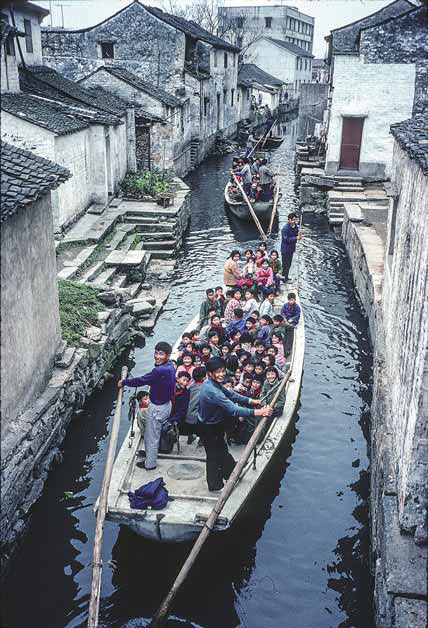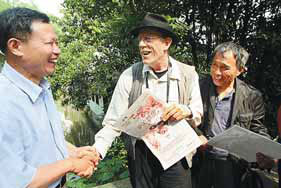A picture in time
Updated: 2013-05-21 07:08
By Wu Ni in Shanghai and Yan Yiqi in Hangzhou (China Daily)
|
||||||||
|
Thurston's photograph of a happy class outing with about 50 smiling children and their teachers. |
|
Thurston shakes hand with Wang Rongxing, one of the boatmen in the original photo taken 30 years ago. Wang Lihong / for China Daily |
A young foreign student snapped a shot of a group of students on a boat trip 30 years ago. Now he is back to find out what had happened to the lives of these students and their teachers. Wu Ni in Shanghai and Yan Yiqi in Hangzhou find out how he reconnects.
Thirty years ago, British photographer David Thurston took what he still thinks is his favorite shot. It was a picture of a boat carrying about 50 children on the waterways of Shaoxing in East China's Zhejiang province. The huge smiles on the young faces seemed to light up the ancient water town in that black-and-white photo.
For years, Thurston had hoped to track the owners of those young faces and find out how their lives has been influenced by the dramatic changes which had happened to China in the past 30 years.
His wish was realized in May this year when the 69-year-old photographer finally stood on the same site and met some of the subjects in his photo.
Despite suffering from Parkinson's disease a few years ago, Thurston never forgot the scene where he took the photo.
It was in 1983 when he had just finished a course in Chinese art history at the China Central Academy of Fine Art, and Shao-xing was one stop in his ambitious trip across China.
Standing on a bridge not far from the former residence of modern Chinese literary giant Lu Xun, he noticed a boat passing under and someone on the boat called out: "Oh look, there's a foreigner!"
All the passengers on the boat looked up and smiled and Thurston pressed the shutter.
"It showed such spontaneous friendliness because I did not ask them to smile," he says. "Not everyone in China would smile at foreigners at that time and many were nervous."
Born in a family of farmers, Thurston was first attracted by China because of its "miracle of feeding a large population with a limited amount of land".
While he was studying politics at the London School of Economics and Political Science, the "cultural revolution" (1966-76) happened, which made him even more eager to know things about China. He learned Mandarin in Cambridge University for a year and then got the scholarship to study at the CAFA.
The "old China" impressed Thurston with big red slogans on the wall, men and women uniformly dressed in blue, brown and grey, and very nervous in speaking to foreigners.
He visited China for a few times after that and was amazed to find more shopping malls and more smiles.
For example, Thurston says, Pudong New District of Shanghai used to be a vast farmland when he visited in the 1980s, but it has some of the world's tallest skyscrapers now.
The dramatic changes must have had impact on the ordinary people's life, Thurston thought, and wondered what kind of life the children of his photo were living now.
"At that time, in 1983, we could expect these children to have similar lives as their parents and grandparents, dressing in the same old blue and gray, because nobody knew the economic change was going to happen," he says.
A Chinese friend posted Thurston's wish and the famous photo on the Chinese micro blog Sina Weibo, and the media in Shao-xing picked up the story and published it in April.
Xu Wenxiang, 67, was the first person to recognize the photo.
She says when she saw the photograph in the newspaper, she remembered the event immediately.
Xu was an elementary school teacher in Shaoxing who retired in 2002. Thurston took their picture when she and her students were on a boat for a spring excursion. Back to 1983, foreigners were rarely seen in a small city like Shaoxing, and that made a deep impression on Xu.
"I never thought I'd see the photographer again. It was like an unexpected gift to me and my two daughters, who were also in the picture," she says.
On May 1, Thurston flew to Shaoxing from his hometown of Totnes in Devon, England, to meet some of the people in the photo.
Wang Rongxing, 60, was one of the boatmen, and he could not believe how wonderful destiny can be.
"When he held my hands on the bridge where he stood 30 years ago, I felt like we have known each other for a long time," he says.
Thurston echoes his feelings.
"I took a photo for them 30 years ago and met them for five minutes and immediately we were friends forever. That is rather sweet," he says.
But perspectives had changed over the years, it seemed. Thurston was astonished to find that the river was no longer as wide or deep. Four years after the photo was taken, it was reclaimed to widen the road.
"I had expected all the things to be the same," he says.
Still he felt happy to see people on the photo are living a better life now, after having a meal in the house of Wang Rongchang, Wang Rongxing's brother.
"His house was clean and seemed to have been refurbished, it was well furnished with an aluminum front door and window frames. The family had traveled to Beijing and elsewhere in China," Thurston says.
"Wang Rongchang had a brand new electric scooter. His bother Wang Rongxing had two daughters at university. They were all casually well-dressed and everyone had mobile phones."
Teacher Zhen Guoxiang who was 25 when the photograph was taken, used to earn just 20 yuan ($3.25) a month. Now, her husband, also a teacher, earns 6,000 yuan per month and they own two apartments.
Thurston left for UK on May 8 but he is expecting more interesting stories from children in the photo.
"I was hoping that maybe some of them have turned up to be chairman of big corporations or a sports celebrity. Perhaps they had gone away to the big cities and did not see the news from local media."
Contact the writers through
wuni@chinadaily.com.cn.
(China Daily 05/21/2013 page22)

 Michelle lays roses at site along Berlin Wall
Michelle lays roses at site along Berlin Wall
 Historic space lecture in Tiangong-1 commences
Historic space lecture in Tiangong-1 commences
 'Sopranos' Star James Gandolfini dead at 51
'Sopranos' Star James Gandolfini dead at 51
 UN: Number of refugees hits 18-year high
UN: Number of refugees hits 18-year high
 Slide: Jet exercises from aircraft carrier
Slide: Jet exercises from aircraft carrier
 Talks establish fishery hotline
Talks establish fishery hotline
 Foreign buyers eye Chinese drones
Foreign buyers eye Chinese drones
 UN chief hails China's peacekeepers
UN chief hails China's peacekeepers
Most Viewed
Editor's Picks

|

|

|

|

|

|
Today's Top News
Shenzhou X astronaut gives lecture today
US told to reassess duties on Chinese paper
Chinese seek greater share of satellite market
Russia rejects Obama's nuke cut proposal
US immigration bill sees Senate breakthrough
Brazilian cities revoke fare hikes
Moody's warns on China's local govt debt
Air quality in major cities drops in May
US Weekly

|

|









